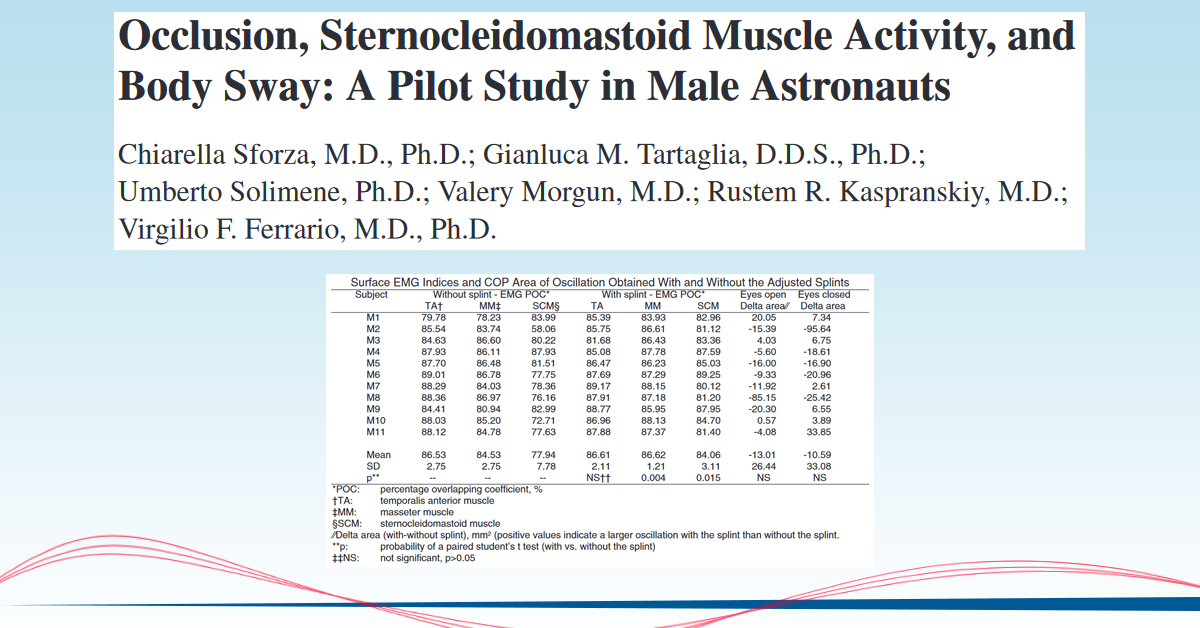Occlusion, neck muscles and balance: possible functional couplings?
Title:
Occlusion, Sternocleidomastoid Muscle Activity, and Body Sway: A Pilot Study in Male Astronauts
Objectives:
The modifications induced by microgravity on the coordinated patterns of movement of the head, trunk, and limbs are reported on extensively. However, apparently, there is little data on the masticatory muscles. In normal gravitational conditions, information from the neck and stomatognathic apparatus play a role in maintaining the body’s balance and equilibrium. The current pilot study used normal gravity conditions to investigate the hypothesis of a functional coupling between occlusion and neck muscles and body postural oscillations.
Material and methods:
The immediate effect of modified occlusal surfaces on the contraction pattern of the sternocleidomastoid muscles during maximum voluntary clenching and on the oscillation of the center of foot pressure was analyzed in 11 male astronauts (aged 31-54 yrs). All subjects were healthy and free from pathologies of the neck and stomatognathic apparatus. Occlusal splints were prepared using impressions of their dental arches. The splints were modeled on the mandibular arch, had only posterior contacts, and were modified to obtain a more symmetric, standardized contraction of the masseter and temporalis muscles during teeth clenching. Surface EMG activity of the sternocleidomastoid muscles was recorded during a maximal voluntary clench with and without the splint. Sternocleidomastoid potentials were standardized as percent of the mean potentials recorded during a maximum contralateral rotation of the head, and the symmetry of the EMG waves of left- and right-side muscles was measured. Body sway was assessed with and without the splint, either with eyes open or closed. The variations of the center of foot pressure were analyzed through bivariate analysis, and the area of the 90% standard ellipse was computed. Within each visual condition (eyes open or closed), the difference between the areas of oscillation measured with and without the splint was computed.
Results:
Muscular activity was more symmetric with the splint. The area of oscillation of the center of foot pressure was larger without the splint than with the splint, both with eyes open and eyes closed. The modifications, induced by the occlusal splint in the sternocleidomastoid muscles’ symmetry, and center of foot pressure differential area with closed eyes, were significantly related (p<0.05): the larger the increment in muscular symmetry, the smaller the area of oscillation with the splint as compared to without the splint.
Conclusion:
A functionally more symmetric maxillo-mandibular position resulted in a more symmetric sternocleidomastoid muscle contraction pattern and less body sway. Modifications in the contraction of the masticatory muscles may therefore affect the whole body.
Practical tip
The analysis of the involvement of the sternocleidomastoid muscles occurs during a 6-channel examination and provides for the introduction of a further measure of normalization of the activity of the sternocleidomastoid muscles. Specifically, it is necessary to explain to the patient that he will be asked to slowly rotate his head first to the right and then to the left in a period of 15 seconds. When performing this movement, make sure that the shoulders are held firm by the patient so that they do not rotate together with the neck. This allows the muscle to perform maximum contraction (maximum contralateral torsion). Subsequently the usual operations foreseen by the protocol of maximum contraction (tightening on the cotton rollers and on own teeth) are carried out.

